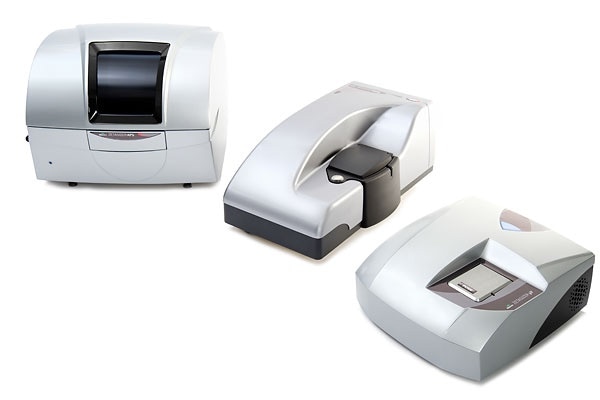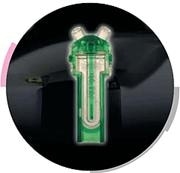The Zetasizer Nano ZS brings you the practicality of a maintenance-free system with the versatility to offer precision measurement for your laboratory's particle characterization needs.

Figure 1. The Malvern Panalytical Zetasizer.
Particle Size
Non-invasive back scatter (NIBSR) technology takes particle sizing to new levels of sensitivity in the 0.6nm to 6 micron range. The new Zetasizer Nano ZS is the choice for accurate, reliable and repeatable size analysis including protein melting point determination.
- Proteins and polymer analysis
- Little or no dilution necessary
- Pharmaceuticals
- Nanoparticles
- Optoelectronics
Zeta Potential
The new Zetasizer Nano ZS offers the highest ever sensitivity, accuracy and resolution of zeta potential. This is achieved by a combination of laser Doppler velocimetry and phase analysis light scattering (PALS) in Malvern Panalytical's patented M3-PALS technique. Even samples of very low mobility can be analyzed and their mobility distributions calculated.
- Emulsion stability
- Formulation stability
- Water treatment
- Pigment performance
- Impurity determination
Molecular Weight
Using static light scattering (SLS) and the classical Debye plot, the molecular weight of random coiled polymers up to 5 x 105 Da as well as globular polymers and proteins up to 2 x 107 Da can be determined without the necessity for multi-angle measurement.
- Protein and polymer characteristics
- Protein crystal screening
- 2nd virial coefficient determination
- Micelle structure
- Protein-ligand binding
Simple Operation
Operating features of the Zetasizer Nano ZS that make it user friendly include:
- Unique maintenance-free zeta potential cell
- No alignment, calibration or maintenance required
- Zeta potential and size can be measured in the same cell
- Automatic cell recognition system
Operating Instructions
The operation of the Zetasizer Nano ZS involves 5 simple steps:
- Power up the Zetasizer Nano ZS and launch the software - An automatic complete system self-check ensures that all components are ready for operation.
- Fill the maintenance-free cell - The amazing low volume, folded capillary cell is the first ever for zeta potential which does not require cleaning. To eliminate cross-contamination, fill it, measure and, instead of cleaning, use a new one.
- Load the cell - Simply insert the cell with its integral gold electrodes, close the lid and it's ready to go.
- Run the measurement - From the menu, select the standard operating procedure (SOP) you need or set your own conditions and click the 'start' button.
- View the results - Predefined reports make reading, comparing and analyzing the results straightforward.
Remove the maintenance-free cell and you are ready to go again.
Designed to Meet Your Needs
At Malvern Panalytical we strive for improvement in every instrument we design and produce. This process is made possible because we continually ask our customers what they think and what they need before turning those wishes into reality.
|
Requested
|
Delivered
|
|
Simple operation
|
Standard Operating Procedures (SOPs) The use of SOPs ensures that measurements can be repeated using exactly the same parameters to give confidence in the result.
|
|
Low volume sample measurement (for valuable proteins and biopolymer samples)
|
A comprehensive range of low volume cells and a unique low volume autotitrator
|
|
Size measurement at low concentrations
|
NIBSR (non-invasive back scatter) technology built in for increased particle sizing sensitivity and to make it possible to characterize proteins and polymers <1nm in size and with molecular weights as low as 1000Da
|
|
Simplified sample preparation - especially for emulsions
|
Instruments which can analyze samples with little or no dilution
|
|
Elimination of sample cross contamination and no need to clean cell or electrodes
|
Unique maintenance-free folded capillary cell. The world's first disposable zeta potential capillary cell
|
|
Ability to measure zeta potential in high salt systems and non-aqueous media
|
Patented M3-PALS (phase analysis light scattering) technology which allows operators to improve resolution as well as automating the process of measurement
|
|
Compliance with regulatory standards
|
Compatibility with 21 CFR part 11 and all other current standards
|
Unique Folded Capillary Zeta Potential Cell
Introducing the unique patented folded capillary zeta potential cell featuring:
- First ever maintenance-free zeta potential cell. Simply use it for a single sample or series of experiments then, instead of cleaning it, use a new cell.
- Gold electrodes for widest range of sample compatibility
- Compact design for low volumes down to just 0.75ml.
- Consistent and stable field held at measurement point

Figure 2. The capillary zeta potential cell for the Malvern Panalytical Zetasizer.
The Zetasizer Nano ZS also accepts the re-usable dip cell which is required for non-aqueous applications - it can also be used for samples dispersed in aqueous media.
Automatic Titration
Automated titration and sample preparation with the MPT-2 Autotitrator
While zeta potential alone is often used to make comparisons between materials and formulations, measuring zeta potential as a function of pH, conductivity or concentration of an additive, provides much greater insight into the processes involved in stabilizing or flocculating disperse systems.

Figure 3. The MPT-2 autotitrator for the Malvern Panalytical Zetasizer.
Using the MPT-2 autotitrator these measurements can be made automatically using samples of less than 3ml, which allows comprehensive analysis of even scarce biological materials.
Operation is fully automated and protocols can be specified as part of standard operating procedures.

This information has been sourced, reviewed and adapted from materials provided by Malvern Panalytical.
For more information please visit Malvern Panalytical.